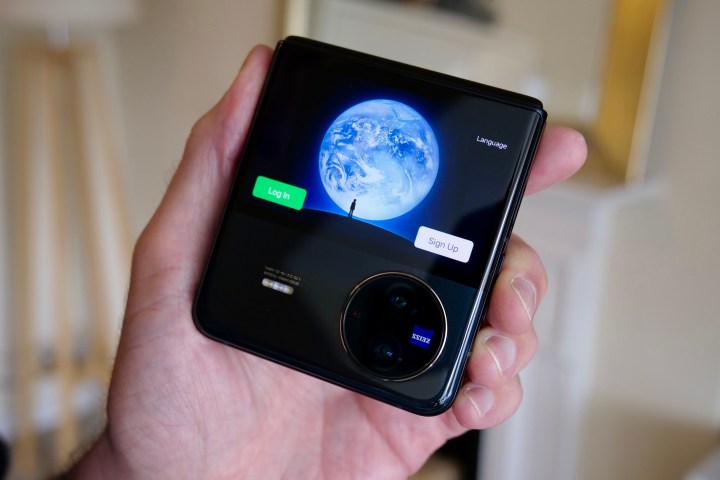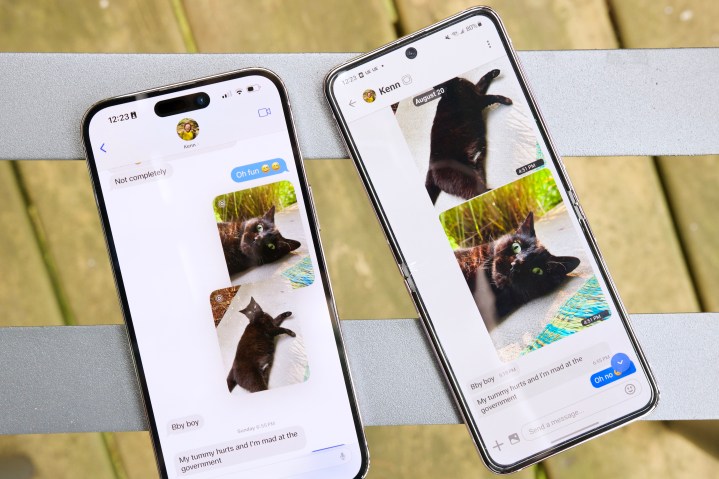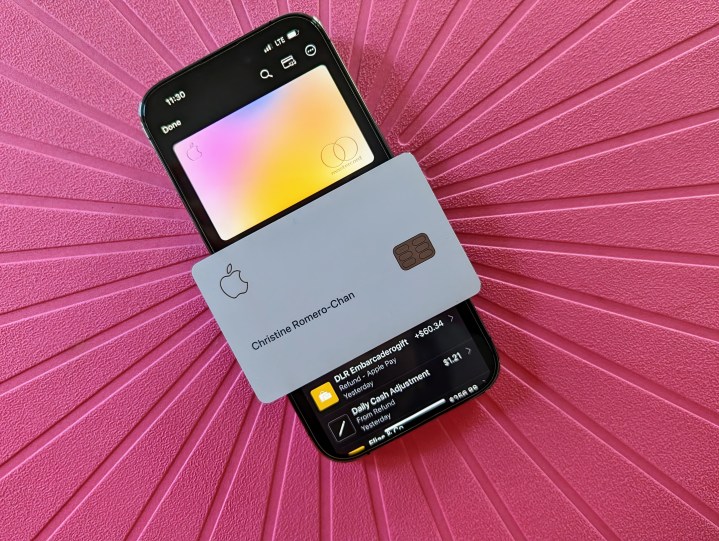
The antitrust season is in full swing in 2024. This time around, Apple is in the cross-hairs of regulators, bringing back memories of the historic Microsoft antitrust case that unfolded over two decades ago. Back then, the focus was on Windows and web browsers. In Apple’s case, the iPhone is the centerpiece, with a wide ecosystem woven around it.
Experts say the case against Apple, which dives deep into monopolistic conduct, is surprisingly strong. The Department of Justice, in its lawsuit, has targeted everything from the iMessage “green bubble” mess and Apple Watch incompatibility situation to the locked app ecosystem and objectionable practices that Apple has put in place to maintain its alleged monopoly.
Apple, on the other hand, says the lawsuit gets the facts wrong. “We will vigorously defend against it,” says the company in a statement shared with Digital Trends. We won’t expect any less from Apple. But the charges leveled against Apple cover over a decade’s worth of product policies — and are extremely comprehensive in nature.
The 88-page legal document is surprisingly easy to digest even for an average person, which is a clear sign that the DOJ really wants it to be an open book for everyone interested, especially the installed base of over two billion active users. Here’s a breakdown of the core issues and Apple’s own takedown for each one:
The Apple Watch situation

“Apple uses smartwatches, a costly accessory, to prevent iPhone customers from choosing other phones,” says the lawsuit. And it’s not just about the iPhone being mandatory for using an Apple Watch, but also limiting some key features if you pair another brand’s smartwatch to your iPhone.
What objections does the lawsuit raise? A lack of a persistent connection between the iPhone and watch, forcing background refresh to keep workout data synced. It also calls out responsive notifications for third-party smartwatches and the degradation of the cellular connectivity lane by forcing users to disable iMessage (which in itself is a lock-in feature)
Apple’s response:
Apple counters this by claiming that it has spent time and resources helping other brands to leverage its APIs (the building blocks behind features) to use their smartwatches with an iPhone, but won’t say if it will address the DOJ’s queries specifically. Apple also touches upon the DOJ recommendation of making a smartwatch targeted at Android users, which, interestingly, the company pursued.
The company says that after dedicating three years to the pursuit of possibly creating an Apple Watch that Android users could call their own, it made the executive decision not to craft a lesser version of its smartwatch. Apple says the prospect of technological constraints that might lower its privacy and security standards didn’t sit well internally.
However, Apple’s retort still doesn’t answer the DOJ’s objections in full. Today, it’s smartwatches – and soon, smart rings, too – that will be caught up in the equation. The bigger question is whether Apple will finally allow feature parity between Apple Watch and third-party smartwatches. Likely, no. Can the regulatory pressure force a course reversal? Possibly, but it could be a while before that happens.
Super apps

Super apps, or everything apps, are fairly popular in Asia. Take, for example, WeChat. It allows everything from messaging and social media to food delivery, online banking, shopping, and even divorce filing. The DOJ lawsuit says Apple kept developers from offering such apps in the U.S. market because doing so would lower the “stickiness” of iPhones, especially if the same app could also be accessed on Android.
“Apple created, strategically broadened, and aggressively enforced its App Store Guidelines to effectively block apps from hosting mini programs,” says the executive law enforcement agency. It adds that Apple reduced the incentive for offering super apps by using tactics like downgrading the UI quality and putting in limitations like API access, despite knowing that such apps are more convenient for users as they reduce the burden of using multiple apps.
After all, if there are 100 taxi apps paying an App Store fee, why let them all live as a mini-program in a single super app and reduce the revenue? Moreover, if these mini-programs take users to a web interface for payments, Apple will be further deprived of the cut it takes when apps use the App Store’s payment pipeline.
Apple’s response:
In a lengthy response shared with Digital Trends, Apple says super apps already exist on the App Store – citing the example of WeChat in China and Tata’s Neu in India – adding that super apps are just not popular in the U.S. Even WhatsApp is turning into one. Aside from messaging, it now allows broadcasts, communities, digital payments, creating virtual storefronts, automated customer responses, catalog creation, integration with Meta ads, and more.
Then there’s the privacy aspect. Apple says without the super app safeguards in place, users would find themselves submitting an entire cosmos of personal information to a solitary app that miraculously manages everything from managing your finances to entertaining your kids. Let users make that decision for themselves. But we also live in an increasingly scam-prone AI-driven world that keeps evolving. So there’s that.
iMessage

A lot has been written about how the iMessage lock-in has thrived over the years, and expectedly, the DOJ sheds light on that. But it sheds light on how Apple keeps some features, such as camera preview for incoming calls. The lawsuit also namedrops the green-blue message bubble wars that have stirred “social pressure” and how Apple blocked end-to-end encryption for messages between Apple Messages and Android users.
The lawsuit also points at public and internal statements from top Apple executives regarding the ecosystem benefits of iMessage and how “moving iMessage to Android will hurt us more than help us.” Also, the recent shutdown of Beeper, which aimed to bridge the iMessage bubble gulf between iPhones and Androids, is a great case study.
Apple’s response:
Apple says if it opens iMessage to non-Apple smartphones, it won’t be able to offer the security assurance that meets its standards, and the same applies to features. On the question of third-party messaging platforms, the company says users already have a wide range of choices to pick from, including WhatsApp, Instagram, and Snapchat.
But the biggest question is the messaging experience. Apple has already committed to RCS (Rich Communication Services), and according to Google, it will be implemented in the fall of 2024. Will the green bubble shame go? Likely no. Will it fully solve the iOS-Android group texting woes? That remains to be seen. But feature parity will finally be here, or at least partially, enabling features like read receipts, high-quality media exchange, reactions, and more.
Apple Pay and Wallet

The DOJ targets Apple’s financial products on the following grounds:
- Apple Wallet is exclusive to iPhones and doesn’t support cross-platform transfer, as that would make it easier for users to look away from iPhones.
- Limiting NFC chip access to Apple Wallet for tap-to-pay transactions.
- Blocking third-party wallet apps from using the native in-app payments system.
- “Apple even prohibits developers on its App Store from notifying users in the developer’s app that cheaper prices for services are available using alternative digital wallets or direct payments.”
- Apple charges banks for Apple Pay transactions, stopping them from developing their own (and possibly better) payment apps.
Apple’s response:
Apple counters that its payment system and wallet app already face tight competition, but more than that, the company is concerned with the privacy and security aspects. Apple says it can’t ensure that another company’s security methods are as good as its own. Moreover, if there’s a security problem with another company’s device, it could lead to iPhone users’ messages getting leaked, leaving them vulnerable to scams and spam.
On the topic of NFC access, Apple says it is opening tap-to-pay for other apps in Europe, but adds that it’s still concerned about security. That begs the question: Why not do the same in the U.S.? It’s possible if we look at the competition, but making Apple follow suit in its home market won’t be a cakewalk.
Apple is ready for a fight

The kind of reforms that the Department of Justice seeks are almost existential in nature. The lawsuit repeatedly mentions “stickiness,” and for good reasons. The iPhone is not like any other Android smartphone out there. It’s an integral part of an ecosystem that covers everything from smartwatches to digital payments. Forcing Apple to make some fundamental changes won’t be easy and could be a long-drawn-out challenge that can take years to bear fruits.
As for Apple, it will certainly argue that it kept innovating and developing features after spending years and millions of dollars in research. If the company can’t offer it to users so that it can get a competitive edge, where do fair market laws sit in that situation?
The DOJ’s arguments are strong, but so is Apple’s clout. What is needed here is nuance and consideration, keeping consumer interests as the top priority. But when there are billions of dollars at stake and subjectively tight competition, nuance goes for a toss in heated courtroom exchanges.
Editors' Recommendations
- This one Apple Fitness feature completely changed how I exercise
- An Apple insider just revealed how iOS 18’s AI features will work
- iPhone 16: news, rumored price, release date, and more
- iPhone SE 4: news, rumored price, release date, and more
- 3 reasons why I’ll actually use Anker’s new iPhone power bank




